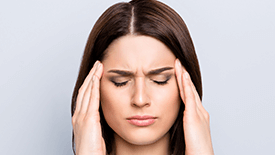Say "No" to the Nocebo Effect
&srotate=0)
What is the Nocebo Effect? How Can This Be Avoided?
“The nocebo effect, the counter effects of the placebo effect, allows negative expectations, perceptions or past experiences of an individual to lead to a negative outcome following an intervention. Studies have shown different methods of avoiding nocebo. Studies have also shown that a person’s genetics, sex and age, medications, personality characteristics, expectations and psychological distress can make a person more prone to the nocebo effect.
There are ways to avoid the nocebo effect. In terms of pain, a person’s psychological distress and predisposition to anxiety may increase negative expectations and outcomes. Therefore, improving a patient's access to information and strengthening their feelings of control over a scenario may help avoid the nocebo effect . Optimizing patient-doctor communication and relationship is one critical way doing so to lower nocebo and improve positive outcomes. Patient expectations can be managed by avoiding an over-emphasis of the adverse effects and providing an emphasis on the positive effects. In order to most effectively reduce nocebo by these means, it requires a doctor being aware of the patient’s emotional state. From here, the doctor may better help the patient better understand the steps of the intervention they are pursuing, how the intervention affects their body, and the likelihood of positive, realistic outcomes.”
- Dr. Raj Maniam
Does the “Power of Positivity” help to explain why placebos promote positive outcomes? If you’re the “glass-is-half-empty” type, are you less likely to experience the placebo effect?
“The power of a placebo has a strong correlation to the psychological factors of a patient. Thus, the power of positive thinking may influence how a placebo works and the measure of its impact. Expectation formation, behavioral practices, and looking at “the glass half full” has shown consistent results across many studies to influence the productivity of patients and a more positive outcome in their treatment. Enabling positive thinking can be thought of as a priming mechanism to boost the non-therapeutic effects of a treatment. The power of positive thinking evokes changes in the neurological processes of one’s brain and makes it more likely to experience the placebo effect.”
- Dr. Raj Maniam
Are placebos an active part of the treatments for most people? It’s not like a doctor can prescribe placebos…right?
“Placebos are not a part of treatment for every person. Most commonly, placebos are used in experiment studies and clinical trials by researchers to determine the efficacy of an intervention. In these trials, any positive outcomes associated with the placebo are essentially ‘subtracted’ from the positive outcomes associated with the intervention in question. If the outcomes are almost the same, it shows that the placebo effect is likely the only helping agent.
Outside of such trials and without full consent of the patient, it is considered unethical to prescribe a patient a placebo drug for their symptoms. Although rarely used, in a consequentialist point of view, a placebo pill may be acceptable––provided there is enough justification that the placebo would elicit significantly more benefits for the patient than no intervention. Unfortunately, such cases of treatment can raise issues of professional dishonesty on the doctor’s behalf… even if it is for the benefit of the patient. This is why it is important for a provider to instead promote healthy, honest, and happy dialogue with their patient so that any nocebo effects can be eliminated. When this happens, it only leaves room for the power of positivity to step in.”
- Dr. Raj Maniam
Edited By: Camden Rowe